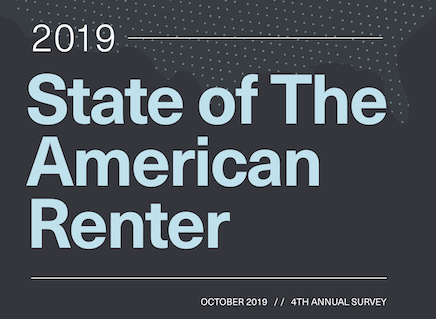
Today, we at Zumper are releasing our 4th annual rental report for 2019. This State of the American Renter Report examines the current status of the U.S. rental market and the shifting mindset of renters. Specifically, the report focuses on the concept of the “American Dream” and how that affects rental behaviors related to transiency, happiness and work, as well as renters’ perspectives on rental rates, savings and cost of living.
Throughout the month of October, Zumper will be featuring an in-depth analysis of specific sections of the report. Continue to check the blog for more details about “The American Dream and Homeownership,” “Millennial Living,” and “The Cities with the Happiest Renters.”
Key Findings & Themes
The idea that the “American Dream” involves homeownership is continuing to shift.
Overall, 32% of respondents said they do not believe that the American Dream involves homeownership, which is in line with Zumper’s previous reports. This continued trend signals a shift away from owning a home as the American goal and reveals new trends in the renter lifestyle. In fact, one in five respondents confirmed they do not have plans to buy a home in their lifetime. And, only 30% of respondents said they planned to buy a home in the next two years, which is down 14 points from the 2018 Renter Report (44%).
People are choosing to rent instead of own due to finances and preferred flexibility.
Overwhelmingly, 62% of respondents ranked “financial situation” as the top reason they rent instead of own, followed by 22% who prefer the flexibility renting brings and 20% who simply do not want the responsibility of homeownership. The younger people are, the more flexibility is a factor when choosing to rent instead of own. As renters get older, the chances of them buying get smaller, making them long-term renters.
Even though rent prices continue to increase across the country, the majority of renters are happy with their living situation.
Surprisingly, 54% of respondents said they think they are getting a good deal on their apartment, which correlates favorably to overall renter satisfaction, with 55% of renters being satisfied with their rental. The top five cities with happiest renters overall are: Miami, FL; Oakland, CA; Austin, TX; San Jose, CA; and Philadelphia, PA.
While renter satisfaction remains the norm, there seems to be a discrepancy between how much of their income renters think they should spend on rent vs. what they are actually spending.
The vast majority, 88% of respondents, said they think one should spend up to 30% of their income on rent. However, one in three respondents find themselves spending more than 31% of their income on rent.
Renters get additional support to pay for rent from roommates, significant others, and parents.
One in four respondents said they live with a roommate, and of those who have a significant other, 40% live with them. 13% of respondents reported living with their parents, up from last year’s report (10%). However, only 6% of respondents said that they still receive help from their parents with their rent, which is down 2% from last year’s report (8%).
As more people choose to rent, lifestyles related to work and transiency are becoming more flexible.
Shockingly, 71% of respondents said they commute less than 30 minutes to work, and one in three said they work remotely. One in four respondents also said they plan to move to another city within the next year with the top destinations being Los Angeles, Atlanta and New York City.
To view the full report, click here.
Methodology
A total of 10,219 respondents age 18+ from all 50 U.S. states as well as Washington, D.C. completed the full survey between May 8, 2019 and June 24, 2019. The survey was sent to Zumper and PadMapper users based in the United States and shared among their family/friends. All responses were gathered online. There are a number of other surveys designed to gather similar data, most notably the American Housing Survey, which is gathered by the Census Bureau. We acknowledge that our data and findings may be impacted by various biases due to the differences between our user base, usually younger with a higher concentration in cities, and the income related biases involved by offering the opportunity to win the survey’s prizes, equal to (2) $1,000 prizes. To help mitigate potential biases in sampling, we strived for the highest possible number of respondents and encouraged sharing to capture as much and as diverse data as possible.



